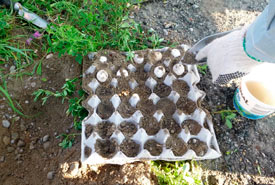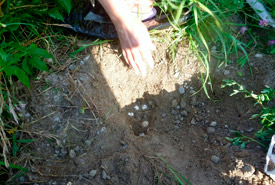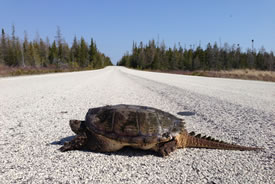Snapping up turtle eggs

Snapping turtle eggs were packed in damp sand for transport. (Photo by David Beevis)
Turtle populations face a number of threats, including loss of habitat and being hit while crossing roads. Recently, turtle populations in a local lake near where we live in Port Hope, Ontario, was exposed to a combination of factors threatening the livelihood of turtles living there.
Turtles have been laying eggs in the gravel shoulders of a short causeway across the lake for many years. To reduce the risk of predation by animals and damage by traffic on the shoulder, volunteers, led by local resident Joan Norris, had marked each nest site and covered them with wire mesh when the turtles nested in the spring.
More recently though, and in response to regular spring flooding, it was decided that the road should be raised, widened and the shoulders paved. The work was scheduled for completion before the due date for the turtle eggs to hatch. This created a crisis for the unhatched turtle eggs. With the construction jeopardizing the current hatch site, the eggs needed to be recovered from the nesting sites and moved for hatching elsewhere (removing eggs from turtle nests is illegal, unless done for a good reason and with a permit).

Unearthing a turtle nest to recover eggs (Photo by David Beevis)
That is how we recently found ourselves at 8 a.m — equipped with trowels, thin gloves, knee pads, markers and egg boxes — among the first of four teams of volunteers organized by Joan to recover the eggs. After removing the protective wire mesh, each nest was carefully uncovered by scraping it with a trowel. Typically, the nests were 10 centimetres deep or more and the gravel and sand around them was surprisingly hard packed. We had to admire the turtles’ ability to dig out and re-cover their nests. More impressive was the idea that tiny, newly-hatched turtles dig themselves out of the nest, unaided, to make their way to the closest body of water. The snapping turtle eggs were a bit rubbery compared to birds’ eggs and about three-quarters the size of a table tennis ball.
All volunteers followed a recommended procedure (Ontario Ministry of Natural Resources and Forestry has prepared two pages of guidance) to successfully remove the eggs. As each egg was carefully uncovered, the top was marked with a marker so that it could be kept upright. This ensured that the eggs are recovered and re-nested without detaching the embryo, and keeps the air bubble at the top of the egg. Around 30 to 48 eggs were found in each nest and stored together, packed in damp sand in egg cartons and other containers.

Snapping turtle on road (Photo by Tricia Stinnissen)
Over two days, 616 eggs were recovered from 18 nests and transported to the Ontario Turtle Conservation Centre (formerly the Kawartha Turtle Trauma Centre) in Peterborough, where they will be hatched and over-wintered. Another 400 or so eggs from 12 nests were transported to turtle nesting sites in the Alderville Black Oak Savanna.
We found the whole experience very calming, even though we will not know if the eggs will hatch successfully. The success rate for recovered eggs is around 50 per cent, compared to an estimated 90 per cent from undisturbed nests. Nevertheless, this is much higher than the survival rate of newly hatched turtles in the wild. By some estimates, a snapping turtle must lay up to 1,400 eggs to replace herself. As of the middle of August, the Ontario Turtle Conservation Centre reported that the eggs were doing well, and that some have started to hatch. The turtles will eventually be released near where they were found.


